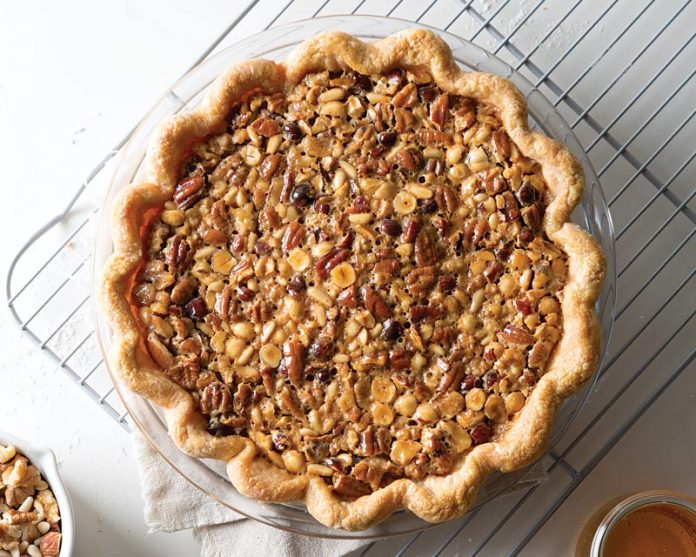
We firmly believe your piecrust shouldn’t just be a vessel for your filling. It’s the foundation for your pie. So we start there, sharing our favorite, foolproof piecrust recipes: Traditional American Piecrust, Pâte Brisée, and Crumb Crust. Bake our Honey Nut Pie (pictured above) recipe that uses a Pâte Brisée crust!
- Traditional American Piecrust
This is the quintessential piecrust. Four simple ingredients—flour, fat, salt, and liquid—fuse to produce a golden, buttery crust with delicate flakes and divine tenderness. (We use butter for the fat and ice water for the liquid.) Our Traditional American Piecrust has more liquid than Pâte Brisée which encourages gluten development to make a stronger, sturdier crust for denser fillings. The excess water also increases the amount of steam while baking, which causes the crust to lift and puff.
The character of your piecrust depends on how you incorporate the fat with the flour. The key to flakiness in our Traditional American Piecrust is minimal mixing with cut-in butter, kept in tiny, whole pieces that are evenly dispersed throughout the dough. As the butter melts in the oven, it gives off water that turns to steam. The super-heated steam puffs up and separates the layers of dough. Whether you mix your dough by hand or use a food processor, the goal is to surround small bits of fat with flour and keep it cold.
For a recipe using Traditional American Piecrust, try our Apple-Cheddar Pie.
2. Pâte Brisée
Brisée is the French term for “broken,” referencing the broken pieces of fat in this shortcrust’s dough. For the Pâte Brisée, we mix flour, salt, sugar, butter, and ice water in a traditional 3:2:1 ratio: three parts flour, two parts fat, and one part liquid. The addition of sugar in the Pâte Brisée wrecks gluten formation, and makes for a crust with some crunch to it. Sugar is hygroscopic, meaning it draws water to it, which helps the dough retain some moisture. Because it caramelizes in heat, sugar also gives the crust a deeper golden color when baked. Because Pâte Brisée has less liquid and less gluten development, it has finer, more delicate crumb than the Traditional American Piecrust. Pâte Brisée is traditionally mixed by frissage, using the heel of your hand to rub and smear butter pieces into the dough. This also causes its texture to be more tender than the traditional crust because the fat is more thoroughly worked into the dough. (The butter is blended with the flour, rather than cut in.) The use of a stand mixer imitates this frissage motion.
For a recipe using Pate Brisée, try our Mexican Hot Chocolate Pie.
3. Crumb Crust
Crisp and crunchy, crumb crusts are just as delicious as your standard piecrust, but even easier to make. Best for holding lighter fillings, crumb crusts are a wonderful way to turn up the texture and flavor—whether you’re looking for a sweet or salty boost. These crusts can be made with everything from cookies and crackers to nuts and ice cream cones. Graham crackers, gingersnaps, vanilla and chocolate wafers, and shortbread are most commonly used for cookie crumb crusts. Because they are subtly salty and a bit buttery, pretzels and saltines are tasty, neutral bases to balance out particularly rich or tart fillings, and work well for savory fillings, too. Almonds, pecans, walnuts, peanuts, macadamias, cashews, and even coconut all work well for nut-based crumb crusts. Finely chopped chocolate, peanut butter, and butterscotch morsels are delicious mix-ins to sweeten up a nutty crust.
For a recipe using a Crumb crust, try our Butternut Squash Pie.




[…] Piecrust Showdown: Traditional vs. Pâte Brisée vs. Crumb […]
[…] Yesterday’s task on Martha’s November calendar in Martha Stewart Living magazine was to Make and freeze pâte brisée. This French term was unfamiliar, so I did a bit of research, and I found that this is a flaky piecrust or pastry. The bit of sugar in the recipe provides the crust the ability to brown, and the ratio of the flour, fat, and water impacts the delicacy of the crust. Here is a detailed summary, as well as a comparison between brisée and traditional piecrust. https://bakefromscratch.com/piecrust-showdown-traditional-vs-pate-brisee-vs-crumb/ […]